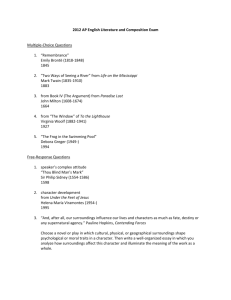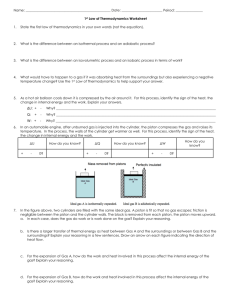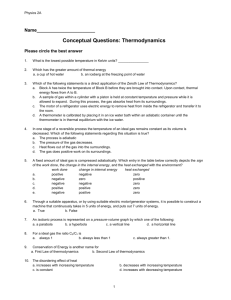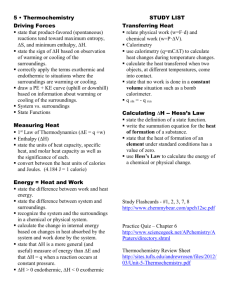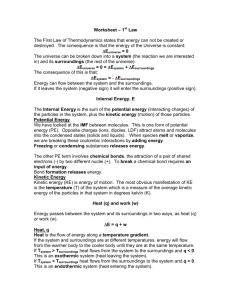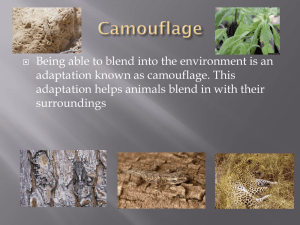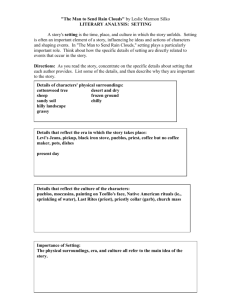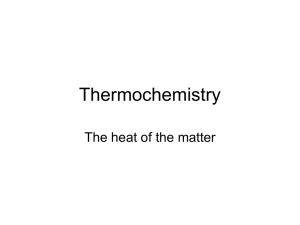1st law of Thermodynamics Worksheet
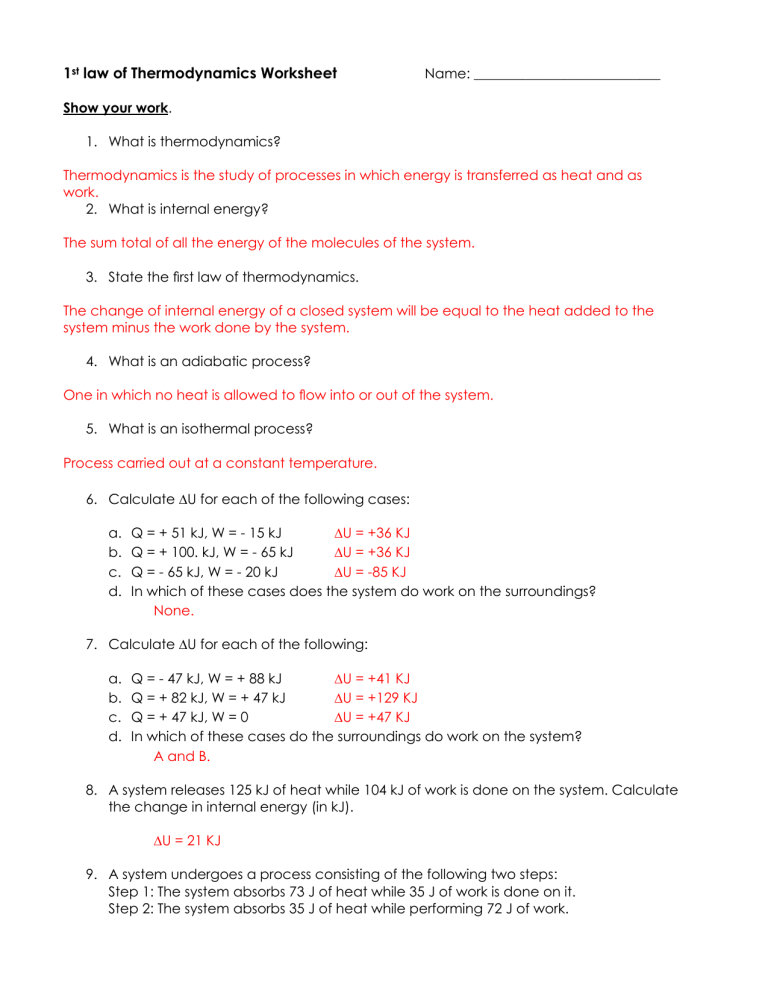
1
st
law of Thermodynamics Worksheet
Show your work.
Name: ___________________________
1.
What is thermodynamics?
Thermodynamics is the study of processes in which energy is transferred as heat and as work.
2.
What is internal energy?
The sum total of all the energy of the molecules of the system.
3.
State the first law of thermodynamics.
The change of internal energy of a closed system will be equal to the heat added to the system minus the work done by the system.
4.
What is an adiabatic process?
One in which no heat is allowed to flow into or out of the system.
5.
What is an isothermal process?
Process carried out at a constant temperature.
6.
Calculate ∆U for each of the following cases: a.
Q = + 51 kJ, W = - 15 kJ ∆U = +36 KJ b.
Q = + 100. kJ, W = - 65 kJ c.
Q = - 65 kJ, W = - 20 kJ
∆U = +36 KJ
∆U = -85 KJ d.
In which of these cases does the system do work on the surroundings?
None.
7.
Calculate ∆U for each of the following: a.
Q = - 47 kJ, W = + 88 kJ b.
Q = + 82 kJ, W = + 47 kJ
∆U = +41 KJ
∆U = +129 KJ c.
Q = + 47 kJ, W = 0 ∆U = +47 KJ d.
In which of these cases do the surroundings do work on the system?
A and B.
8.
A system releases 125 kJ of heat while 104 kJ of work is done on the system. Calculate the change in internal energy (in kJ).
∆U = 21 KJ
9.
A system undergoes a process consisting of the following two steps:
Step 1: The system absorbs 73 J of heat while 35 J of work is done on it.
Step 2: The system absorbs 35 J of heat while performing 72 J of work.
Calculate the change in internal energy for the overall process (in J).
Step 1: ∆U = 108 J
Step 2: ∆U = 37 J
Total: ∆U = 145 J
We will now investigate two thermodynamic systems.
In the figure above, two cylinders are filled with the same ideal gas. A piston is fit so that no gas escapes; friction is negligible between the piston and the cylinder walls. The block is removed from each piston, the piston moves upward.
10.
In each case, does the gas do work or is work done on the gas? Explain your reasoning in a few sentences.
In both A and B, the gas expands against the surroundings. Work is done on the surroundings (w
< 0) because the external pressure suddenly decreases as the weight is removed from the piston and the gas expands to match the external pressure.
11.
Is there a larger transfer of thermal energy as heat between Gas A and the surrounding or between Gas B and the surroundings? Explain your reasoning in a few sentences.
Draw an arrow on each figure indicating the direction of thermal energy flow.
There is a larger transfer of thermal energy as heat between Gas A and the surroundings because it is an isothermal expansion. In order to compensate for work being done isothermally on the surroundings, thermal heat must enter the system to maintain the temperature of the expanding system. Arrow: pointed into the system!! There is NO transfer of thermal energy as heat between Gas B and the surroundings because it is a well-insulated system and by definition heat cannot flow into or out of the system. Therefore, the temperature of the system decreases. Arrow: There is not an arrow!!
12.
For the expansion of Gas A, how do the work and heat involved in this process affect the internal energy of the gas? Explain your reasoning in a few sentences.
Δ U = 0 and W = -Q.
There is no temperature change in an isothermal process; therefore, the Δ U = 0 and W = -Q.
The system does work on the surroundings and the work is compensated by heat from the surroundings. work out = - heat in
13.
For the expansion of Gas B, how do the work and heat involved in this process affect the internal energy of the gas? Explain your reasoning in a few sentences.
Q = 0 and Δ U = W
This is an adiabatic process; therefore, Q = 0 and Δ U = W. Since the system does work on the surroundings, work < 0 and the internal energy decreases which corresponds to a decrease in the temperature.
We will now investigate a real-life example!
Use the figure above to make a prediction.
14.
What happens to the temperature of the gas inside the can as you allow the gas to expand into the balloon?
The temperature of the gas decreases because you are expanding the gas.
15.
Why does this temperature change occur? Explain the reasoning for your answer in a few sentences.
Note: Consider the system to be the balloon, the can, and the gas, everything outside of the can and balloon is considered the surroundings. There is NO loss of gas molecules during this expansion.
This is an ~ adiabatic expansion. Work is done on the surroundings, but no heat (initially) enters the system. U = Q + W (where Q=0), so U = Q. If work is done on surroundings (W < 0), then the internal energy must decrease, and therefore the T decreases: Δ U=C
V
Δ T or W ad
= C
V
Δ T
Now test your prediction with one of the air cans at the front of the room and make any necessary corrections to your answers above.
16.
Initially (within the first minute of the expansion), is this example more like an isothermal expansion or an adiabatic expansion? Explain the reasoning for your answer in a few sentences.
This is like an adiabatic expansion. The expansion happens much faster than the transfer of thermal energy between the system and the surroundings. Even though the can is not insulated,
the expansion is quick and the transfer of thermal energy as heat is slow to enter the can and restore the temperature to that of the surroundings.

